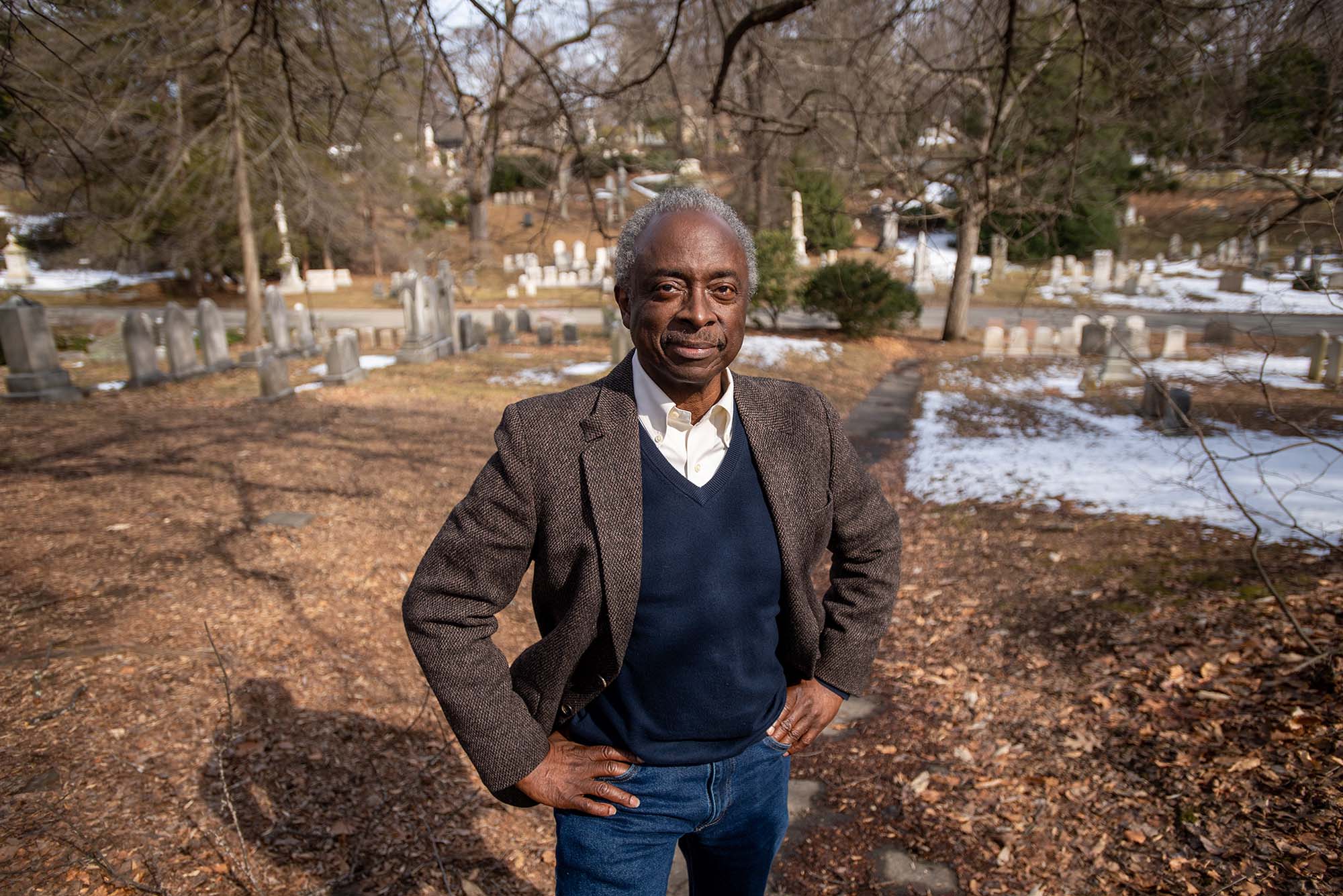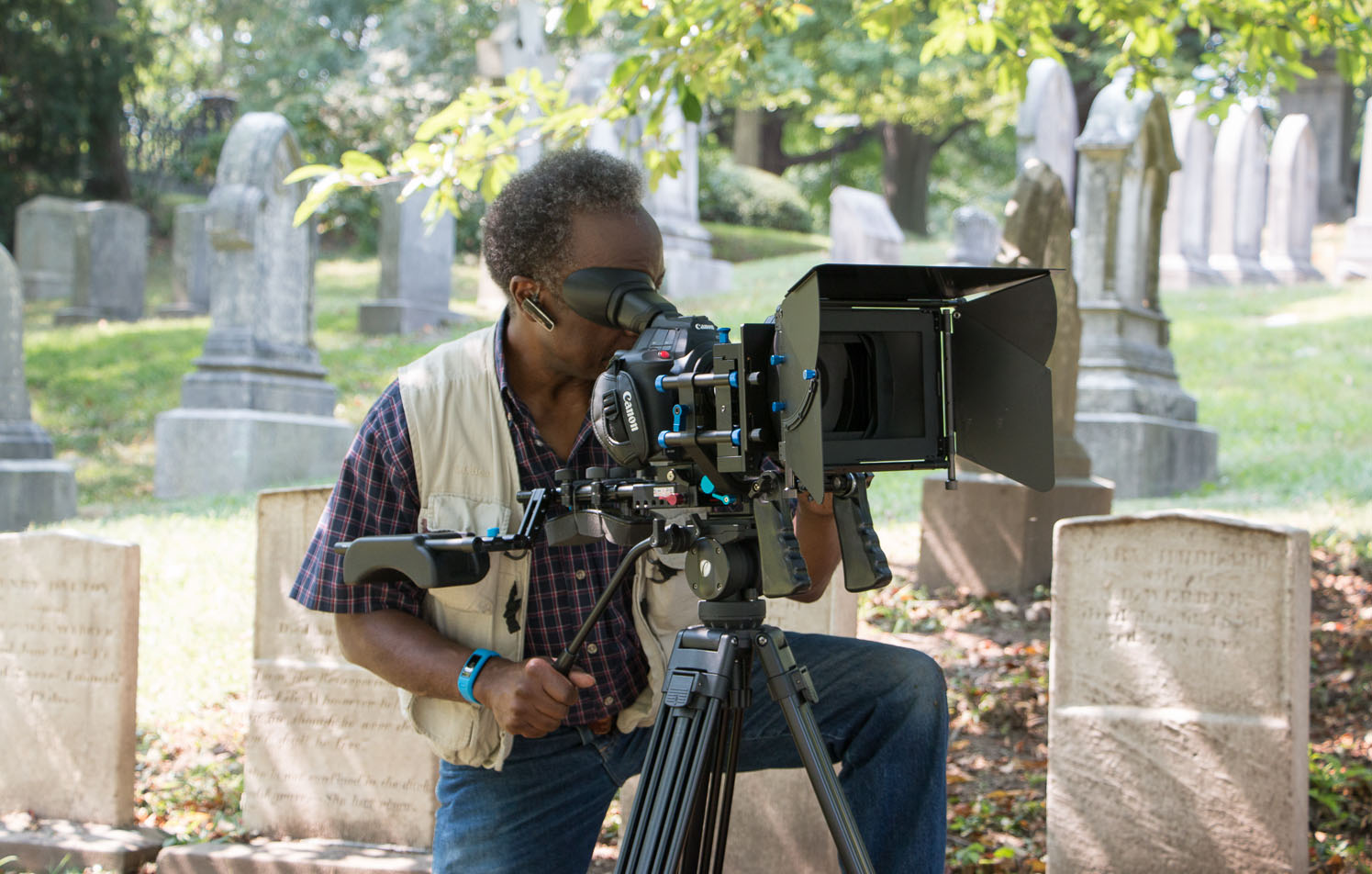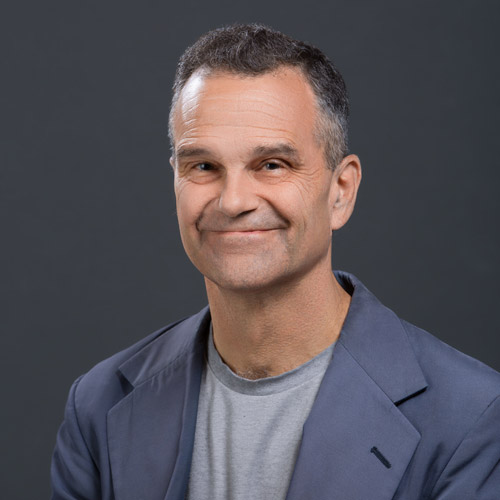From Alum Roberto Mighty, World’s Greatest Cemeteries, Debuting Easter on Boston PBS, Profiles Magnificent Resting Places for Eternity
Six-part documentary by Roberto Mighty (CAS’76) launches April 17 on GBH-2

Filmmaker Roberto Mighty (CAS’76), at Mount Auburn Cemetery, profiles that and other renowned burial sites in his six-part PBS series World’s Greatest Cemeteries, premiering April 17 on Boston GBH-2. Photo by Cydney Scott
BU Alum Explores World’s Greatest Cemeteries in New PBS Series
Six-part documentary by Roberto Mighty (CAS’76) launches April 17 on GBH-2
Among the dead, filmmaker Roberto Mighty discovered one passion of his life…
It started during his 2014-2015 stint as the first United States artist-in-residence at a cemetery. Captivated by the beauty of Cambridge’s Mount Auburn Cemetery—and by the stories of those interred there, famous and not—“I began wondering about other cemeteries around the world,” Mighty (CAS’76) recalls.
Wondering led to a six-part PBS series, World’s Greatest Cemeteries, debuting Sunday, April 17, at 11:30 am on Boston’s GBH Channel 2. (The show has already debuted on other PBS stations.) PBS members can stream the series on the network’s Passport service beginning May 1.
For Mighty, World’s Greatest Cemeteries, along with two other recent projects for PBS (his 13-parter on aging, getting dot OLDER and the film Legacy of Love, about Martin Luther King, Jr. [GRS’55, Hon.’59] and Coretta Scott King), mark his foray into national television. Mount Auburn Cemetery is the focus of the first episode, with remaining segments devoted to Highgate Cemetery in London, Green-Wood Cemetery in Brooklyn, N.Y., Hollywood Forever Cemetery in Los Angeles, Spring Grove Cemetery and Arboretum, in Cincinnati, Chateau de Monte Cristo, in Paris, and in a circle-back to Greater Boston, the Granary Burying Ground, final resting place of American Revolutionary War notables and war dead.
It was Mighty’s film on the Kings that first caught the attention of Ron Bachman, GBH’s senior director of programming. The station aired it in 2020, “and I’ve been interested in his subsequent work since then,” Bachman says. “Airing the series is a wonderful opportunity to highlight the work of a local producer covering local subject matter for our viewers,” since Mount Auburn kicks off World’s Greatest Cemeteries.

“Roberto has beautifully captured Mount Auburn as a place of burial and commemoration, and also a place that comforts, teaches, and inspires all who visit,” says Bree Harvey, Mount Auburn’s vice president of cemetery and visitor services.
“Each of the cemeteries he visits is a cultural organization in its own right, with layers of art, nature, and history that tell the story of their local communities. I hope that viewers come away from this series with a deeper appreciation for the importance of all cemeteries, as places that are meant just as much for the living as they are for the dead.”
The series delves especially into the lives of those buried in the featured cemeteries. “I do feel that I am bringing these people’s stories back to life, and I have a sense of mission about that,” Mighty says.
“I’m interested in outsiders,” he adds. “I’m interested in people who were lesbian, gay, transgender, people who were Black, Jewish, Catholic.” One episode profiles African American/Native American sculptor Edmonia Lewis. While hardly a household name today, Lewis was internationally known during the Civil War and the Gilded Age. She’s buried in London, but her sculpture of the goddess Hygeia is displayed at Mount Auburn.
Guiding Bostonia on a walking tour of that cemetery on a recent, radiantly sunny day, Mighty describes how its layout has been a blueprint for the nation’s changing notions of privilege and caste during the burial ground’s 191 years. “We just passed an area set aside for people of Scottish descent,” he notes. “Why would that be? Why is it that there’s a separate Catholic cemetery adjacent? We can look back at…the history of oppression of minority groups, [at] the self-segregation of certain kinds of groups.”
In many cemeteries, the most expensive plots top hills with magnificent views, he says, and although the dead clearly can’t enjoy those vistas, “people are replicating in the cemetery the same social strata that they lived in, or endured, while they were alive.”
I do feel that I am bringing these people’s stories back to life, and I have a sense of mission about that.
When a gravesite upends this stratification, it’s a story. One Mighty tells in the series is about a nondescript headstone that a visitor to Mount Auburn would miss, yet a history changer lies here: Dorothea Dix, a nurse and reformer whose advocacy in the 1800s led to America’s first asylums, a compassionate leap forward from the brutalization of impoverished patients theretofore. The understatement of her grave reflects its occupant’s “modest lifestyle,” Mighty says. “This is surely in keeping with her personality.”
Cemeteries spanning centuries hold notables from numerous eras. Among London’s Highgate Cemetery occupants are literary heavyweights spanning the 19th century (novelist George Eliot, author of Middlemarch and Silas Marner) to the 20th (Douglas Adams, who wrote The Hitchhiker’s Guide to the Galaxy).
Although educated in Beantown and residing in central Massachusetts, Mighty is not partial to the local sites. “I don’t have a favorite cemetery,” he says. His eye gravitates toward the visual beauty of all these fabled places, from their horticulture to their architecture, and his history major’s mind is intrigued by their residents’ biographies.
He worked both behind the camera and in front, narrating and doing interviews during the series’ three-year gestation. Production overlapped with the pandemic, which tragically swelled cemeteries around the world. Mighty avoided the subject: “I didn’t want to focus on COVID, because I knew it was not going to last forever.”
After six shows, he hasn’t run out of cemeteries. When the series debuted on public television last fall, he received fan letters from viewers around the world, suggesting other burial grounds to profile. “By November, it was clear that we were going to have to do another season,” he says. Work on that second season has begun, and it will include Sleepy Hollow Cemetery in Concord, Mass., the final resting place of Henry David Thoreau, Louisa May Alcott, Ralph Waldo Emerson, and Nathaniel Hawthorne.
“People are very passionate about the cemetery that’s important to them,” Mighty notes, “very often because their parents are buried there.” The series conjures for him his own late parents, who, he muses, probably would have wanted work like this for him. “Growing up, our house was all about history and world affairs, and that was the common discussion at the dinner table,” he says. “If they were alive, I think they would love to go on some of these trips and hang out.”
This documentarian of the dead has made arrangements for his own burial location. Asked for details, he demurs. “I think that’s private. I will say, though, that a place like this [Mount Auburn] certainly is the kind of place where I’d like to be buried or have my ashes.”

Comments & Discussion
Boston University moderates comments to facilitate an informed, substantive, civil conversation. Abusive, profane, self-promotional, misleading, incoherent or off-topic comments will be rejected. Moderators are staffed during regular business hours (EST) and can only accept comments written in English. Statistics or facts must include a citation or a link to the citation.